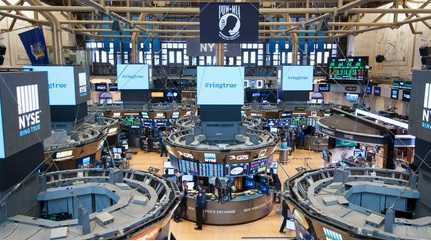
NEW YORK (AP) — Wall Street is drifting on Friday as stocks head toward the close of their worst week since December.
The S&P 500 was virtually unchanged after flipping between small gains and losses through the morning. It’s on pace for a 1.3% loss for the week. The Dow Jones Industrial Average was up 75 points, or 0.2%, at 33,775, as of 11:15 a.m. Eastern time, while the Nasdaq composite was 0.6% lower.
Stocks have been struggling since rallying at the start of the year on hopes that the economy could avoid a severe recession and that cooling inflation could get the Federal Reserve to take it easier on interest rates. Since late last week, worries have risen that a still-strong jobs market could up the pressure on inflation and keep the Fed on track to leave rates at the higher-for-longer level that it’s been talking about.
Higher rates can drive down inflation but they also raise the risk of a recession and drag down investment prices. And central banks around the world are intent on tightening the screws further by raising rates, even if at a slower pace than before.
“For most central banks the risk is that they have tightened too little, not too much,” economists led by Ethan Harris wrote in a BofA Global Research report.
“The ultimate gauge of success here is not avoiding a recession, but getting inflation on a path back to target,” Harris wrote.
The worries about rates mean much of Wall Street’s action has been in the bond market, where yields have climbed on expectations for a firmer Fed.
The yield on the 10-year Treasury, which helps set rates for mortgages and other important loans, rose to 3.71% from 3.66% late Thursday. The two-year yield, which moves more on expectations for the Fed, ticked up to 4.51% from 4.48%. It was at 4.08% just over a week ago and is near its highest level since November.
One area the Fed has focused on keeping under control is expectations for inflation among U.S. households. If those took off, the fear is that a self-reinforcing cycle could take hold that only worsens inflation.
A preliminary report Friday showed expectations for year-ahead inflation rose to 4.2% from from 3.9% in January, according to the University of Michigan. But that’s still down from 4.4% in December. The report also showed mixed sentiment about the economy, though the overall reading was a bit better than expected.
Companies in recent weeks have also been delivering a mixed set of earnings reports for the end of 2022.
Lyft tumbled 35.4% following its latest report. The ride-hailing company gave a forecast for revenue in the first three months of 2023 that fell short of analysts’ expectations.
Newell Brands, whose brands include Sharpie markers and Calphalon cookware, fell 3.2% despite reporting stronger revenue and profit for the latest quarter than analysts expected. Forecasts for revenue and earnings this upcoming year were below analysts’ forecasts.
Given worries about still-high inflation and a slowing economy eating into corporate profits, analysts have been cutting their forecasts for upcoming earnings for companies. So far this year, analysts have cut their expectations for S&P 500 companies’ first-quarter earnings by 4.5%, according to strategists at Credit Suisse. That’s a deeper cut than average.
News Corp. fell 8.5% after the owner of The Wall Street Journal and other media reported weaker quarterly results than expected. It also said it will cut 5% of its workforce in 2023 as it contends with higher interest rates and inflation. Layoff announcements have been spreading across more industries after earlier focusing mostly on the tech sector.
Expedia lost 7.8% after reporting weaker profit and revenue for the latest quarter than expected.
On the winning side of Wall Street were energy stocks, which rose with the price of crude oil. Marathon Oil climbed 4.8%, and Valero Energy gained 4.6%.
Oil prices rose after Russia announced Friday that it will cut oil production by 500,000 barrels per day next month. Western countries had capped the price of Russia’s crude over its invasion of Ukraine. Brent crude, the international standard, rose 2.5% to $86.62 per barrel.
Benchmark U.S. crude added 2.1% to $79.69 per barrel.




